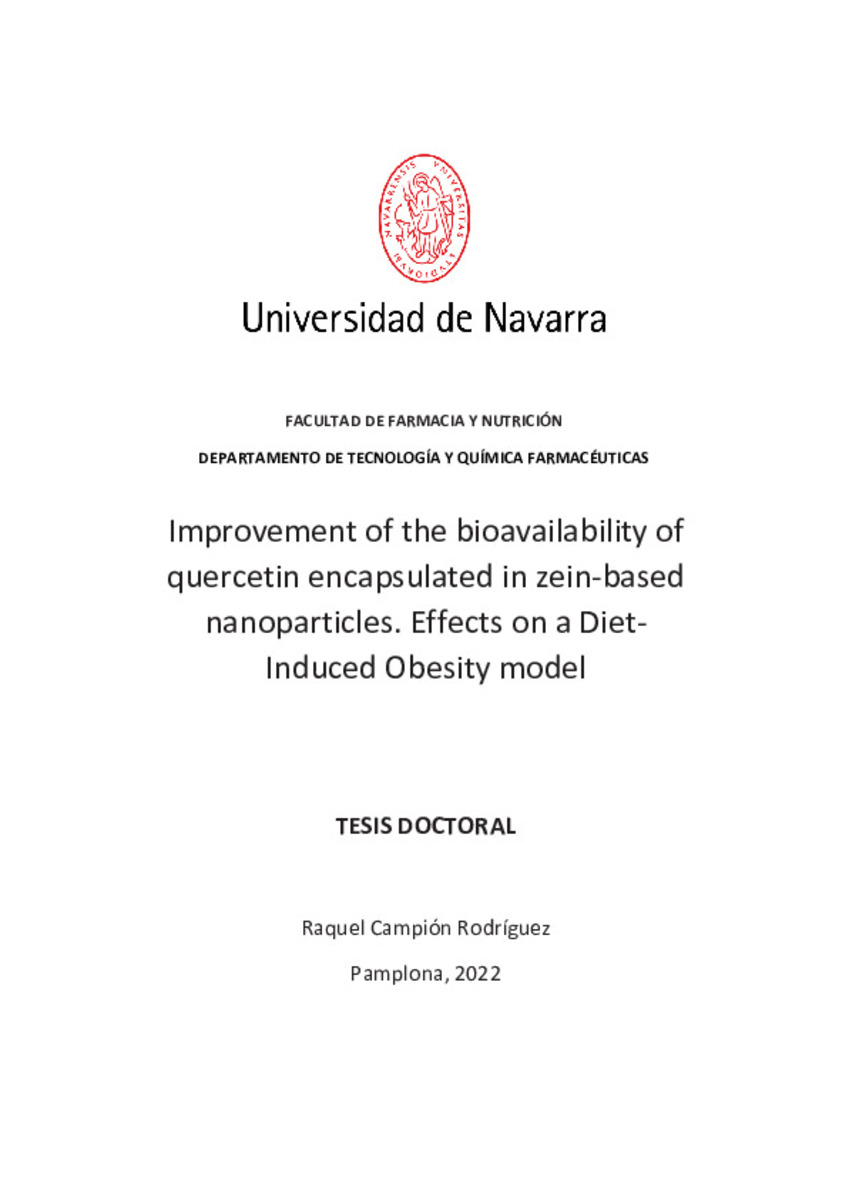Full metadata record
| DC Field | Value | Language |
|---|---|---|
| dc.contributor.advisor | Irache, J.M. (Juan Manuel) | - |
| dc.contributor.advisor | Gonzalez-Navarro, C.J. (Carlos Javier) | - |
| dc.creator | Campión-Rodríguez, R. (Raquel) | - |
| dc.date.accessioned | 2022-11-28T11:50:39Z | - |
| dc.date.available | 2022-11-28T11:50:39Z | - |
| dc.date.issued | 2022-11-28 | - |
| dc.date.submitted | 2022-11-25 | - |
| dc.identifier.citation | CAMPIÓN, Raquel. "Improvement of the bioavailability of quercetin encapsulated in zein-based nanoparticles. Effects on a Diet-Induced Obesity model.". Irache, J.M. y González, C.J. (dirs.). Tesis doctoral. Universidad de Navarra, Pamplona, 2022. | es_ES |
| dc.identifier.uri | https://hdl.handle.net/10171/64736 | - |
| dc.description.abstract | Flavonoids are a subclass of polyphenols, the most common and widespread group of substances in plants. They have been demonstrated to exert several beneficial health effects, such as anti-obesity or anti-diabetic ones. However, they present low water solubility and low oral bioavailability, what produces a reduction of the efficacy. For that reason, some strategies must be followed, such as the nanoencapsulation of these bioactive compounds. Thus, this doctoral thesis was focused on the development and characterization of nanoparticles made of a vegetal protein intended for the oral delivery of flavonoids, and its evaluation in in vivo models of obesity. In this work, the development of nanospheres made of a vegetal protein was performed. Two strategies were followed to improve the characteristics of these nanospheres. First, a hydrophilic polymer was used to coat the device, in order to improve its intestinal mucus-permeating characteristics. Second, nanocapsules (containing an oily core) were developed, with the aim of improving the loading of the flavonoid and the in vitro release properties in simulated gastric and intestinal fluids. Once the nanoparticles were developed, a flavonoid was loaded. Empty and flavonoid-loaded nanoparticles were characterized by measuring the size, zeta potential, morphology, hydrophobicity of the surface, diffusion in intestinal mucus, and the in vitro release. As a first approach, nanoparticles were evaluated in a model of increased fat accumulation in the nematode Caenorhabditis elegans. Results showed that the flavonoid decreased the fat accumulation compared to the control, even more when encapsulated in nanospheres (bare or coated ones). On the contrary, nanocapsules did not have an effect. The in vivo gastrointestinal transit and biodistribution of nanoparticles were also analyzed in Wistar rats, using radiolabelled or fluorescently marked nanoparticles. Nanocapsules were the fastest formulation, and the mucus-permeating properties of coated nanospheres were confirmed. In addition, a pharmacokinetic assay was carried out, showing that the nanoencapsulation of the flavonoid improved the pharmacokinetic parameters and relative oral bioavailability. Finally, nanoparticles and free flavonoid were evaluated in a model of diet-induced obesity (DIO) in Wistar rats. The DIO model was successfully achieved by feeding rats with a high fat/high sucrose diet, and coated nanospheres displayed more positive effects than other treatments; some white fat depots and size of adipocytes, serum triglycerides and glucose, plasma monocyte chemoattractant protein-1 (MCP-1), hepatic steatosis, and hepatic triglycerides were reduced. Also, in the retroperitoneal fat, the treatment with coated nanospheres overexpressed genes involved in the β-oxidation of fatty acids, genes encoding two adipokines, and a gene involved in the browning of fat. In summary, nanoparticles made of a vegetal protein were successfully prepared and characterized. A flavonoid was loaded, and the anti-obesity effect of the free and encapsulated compound was confirmed in the nematode C. elegans and in a diet-induced obesity model in rats. | es_ES |
| dc.language.iso | eng | es_ES |
| dc.publisher | Universidad de Navarra | es_ES |
| dc.rights | info:eu-repo/semantics/openAccess | * |
| dc.subject | Materias Investigacion::Farmacia::Farmacia y farmacología | es_ES |
| dc.subject | Quercetin | es_ES |
| dc.subject | Obesity | es_ES |
| dc.subject | BMI | es_ES |
| dc.subject | Adipose tissue | es_ES |
| dc.subject | Zein-based nanoparticles | es_ES |
| dc.title | Improvement of the bioavailability of quercetin encapsulated in zein-based nanoparticles. Effects on a Diet-Induced Obesity model. | es_ES |
| dc.type | info:eu-repo/semantics/doctoralThesis | es_ES |
| dc.identifier.doi | 10.15581/10171/64736 | - |
Files in This Item:
Statistics and impact
Items in Dadun are protected by copyright, with all rights reserved, unless otherwise indicated.






